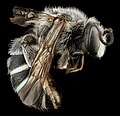| Nomia universitatis | |
|---|---|
 | |
| Female | |
| Scientific classification | |
| Domain: | Eukaryota |
| Kingdom: | Animalia |
| Phylum: | Arthropoda |
| Class: | Insecta |
| Order: | Hymenoptera |
| Family: | Halictidae |
| Genus: | Nomia |
| Subgenus: | Nomia (Acunomia) |
| Species: | N. universitatis |
| Binomial name | |
| Nomia universitatis Cockerell, 1908 | |
Nomia universitatis is a species of bee in the family Halictidae. It is native to the continental United States. [2] [3]
- Male
- Female, back view
- Male, face



